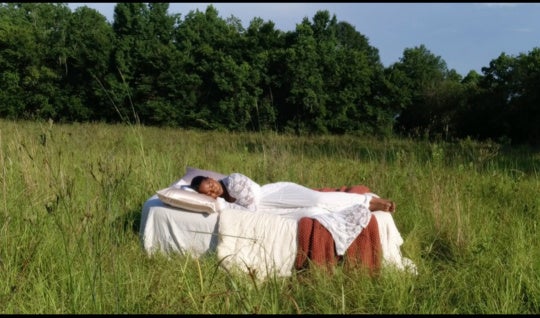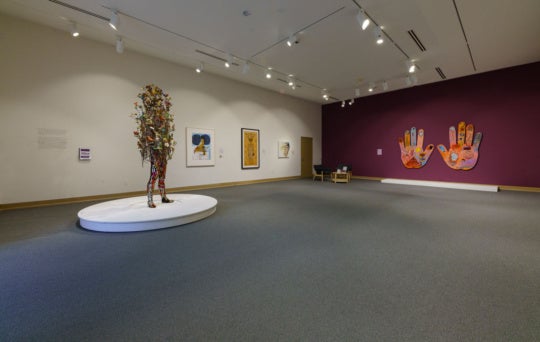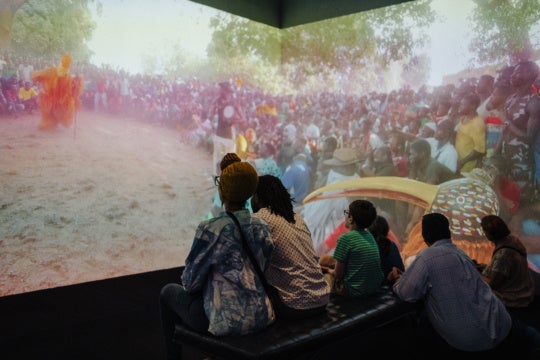
Luba Lukova is a New York-based artist and designer known for her work using simple, bold designs to convey powerful messages. Her current solo exhibition, “Designing Justice” at the Museum of Design Atlanta through September 3, features 60 of her socially engaged pieces intended, she says, to get visitors to empathize with the various social issues and inspire them to talk about how they can effect change.
Lukova was born in Plovdiv, Bulgaria, where she studied at the National Academy of Fine Arts in Sofia. After graduating she moved to Blagoevgrad where she began designing posters for a local theater. This experience and the oppression she faced as an artist in Communist Bulgaria shaped her graphically powerful style before she moved to the US at age 29.
Since then Lukova has exhibited internationally, including at UNESCO headquarters, Paris; La MaMa La Galleria, New York; and the Art Institute of Boston. Her work has been included in the collections of the Library of Congress and the World Bank, Washington, DC; Bibliothèque Nationale de Paris; and the Museum of Modern Art in New York.

Did you grow up looking at a lot of propaganda?
I grew up in the ’80s in communist Bulgaria, so yes. They produced a lot of posters that would advertise — or not really advertise but rather brainwash. It was brainwashing because there was no competing message. The government controlled everything, so they were just promoting the rules of the Party in posters.
The posters said all kinds of things, like, for example, promoting Lenin’s birthday or Lenin’s anniversary, this and that. “The Party says that you should not drive and drink.” Another example, “Kids should drink milk, the party says.” All this was coming from a “big brother” and it was very direct, like “do this or don’t do this,” “that’s wrong, that’s right.” There wasn’t an element of subtlety or discovery. Yes, they were done by artists who knew how to paint well, but there was never an element of beauty, something that would make you reflect in yourself, or something that could bring out an emotion. Everything was just an order.
Of course, there was a lot of anti-USA propaganda, anti-anything from the Western world really. Communism took power in Russia in 1918, and that’s when they started replacing the so-called bourgeois art with propaganda. Now when you look back, it was decades ago. To some people a lot of these prints and artifacts have a vintage flare. I will never look at them from that angle. I know these are very interesting to a Western person, to see the Cyrillic alphabet and these stylized figures, but for me the meaning and the purpose represented something completely different. It deprived us of basic freedoms, no doubt. It was something we lived with. Some of the people who made this were good artists, but if you understand the language, if you know the message and what they say, and if you know a little bit of the context of the real situation, then you will see that they were not pieces about joy and enthusiasm. They were the opposite.
Even as a kid, they never made me feel joyous, didn’t make me smile. They always scared me.

How did you get your start as an artist?
I started doing my poster work in a theater in a small city. All of the theater artists had been sent there. They were doing like descendent kind of work as much as they could because everything was such a controlled answer. To me it was about finding like-minded people and just helped me to grow and understand more how the arts are affected by this situation.
Most of the plays that were staged there were the classical plays that were staged with a double meaning. That was a very interesting experience for me and it helped me to grow and to realize how to find my language. When I was doing these posters, I wanted to do the kind of work that had a nuance of meaning and would be beautiful to discover and look at. They would put my posters on the theater facade, and the next day they would tell me some people had stolen my posters. To me that was like the biggest reward if someone steals it– and you see the propaganda stuff from the Party, nobody wanted that. I was doing something different. It was just like a small city and a small group of like-minded people, but we were just trying to do our job and we knew that we were watched. When something like this happens and you see people are quiet, maybe they don’t say anything, but everybody has something inside and that’s how they express it.

You spoke a a lot about empathy, and how you want to elicit empathy from viewers.
Art is a way to make people connect. It’s the great unifier. We are so divided in the US today. There is no one who could disagree. So why don’t we just agree that we have to fight these serious issues together? We have to feel empathy for each other. If you don’t feel empathy, then everything is meaningless because it means that progress depends on only a few people. If there is no empathy, human progress will not be possible — you see how many revolutions and movements in society are just about that, a huge number of people struggle. I feel empathy is the purpose of art.
My favorite pieces of theater are all about that – they make you feel and they make you feel for someone else instead of having self-pity. They make you sympathize with someone else’s struggle or jive with someone else’s success and that’s the beauty, that art can really make you a better person in that way.

I did a piece for a show I had in Alabama around the 50th anniversary of the Civil Rights Movement. I started reading about it. I knew that Dr. King wanted this to be a peaceful protest and organized sit-ins. Dr. King was very inspired by Mahatma Gandhi. It really struck me that someone can just sit in a chair and not do anything — they’re just sitting, not screaming or marching, just sitting. The protest drew policemen with dogs. So in my work, I juxtapose the dream and the teeth of the dog. I’m not quite combining the two. I basically depict what happened, but with a little twist, it becomes something different. It becomes something which is realistic but not that realistic because I didn’t show the policemen holding the dogs, and a person could never hold “I have a dream” in the palm of their hand like Dr. King does in my piece.
How did you develop your style? What influenced you?
In school we were never asked to look for a style because that can be very limiting, especially when you are searching for your own voice. But when I started working in the theater, all of the work I was doing was printed and displayed in the public space. It had to be visible from a long distance and to be understood, so naturally you have to work in bolder shapes and lines. I learned what is most effective for this type of work, and I played with it. But experimenting is something that every artist does.
I grew up in Bulgaria, which is very close to Greece. At some point in history they were one country. There are a lot of museums in Bulgaria that have Greek vases, and I was fascinated by that. The simplicity of the drawings, the beauty of the line, and how just with a few strokes they represent human emotion, or movement, or physical beauty. The strong, contrasting rhythm that the positives and negatives had really intrigued me.

Public art needs to be bold and bright. Something that I realized about theater is that it is the same story told in different ways. People come and see it all the time, they’re never bored with it, because we as people like to see ourselves in art. In visual art, too, I’ve noticed that the human form grabs the viewer’s attention more, your eye goes there. Art mirrors life.
I’ve never really looked for a consistent style that I work with because the work varies. There are similarities, but I always look for simple, stylized form, and always some kind of human element.
This is an exhibition of images that reflects the social commentary of our time. We all know some things needs to be improved, otherwise we are all going to suffer. Art can help in that dialogue.
Can you talk about your use of humor to symbolize these emotionally difficult ideas?
Humor is very important. Everything that you see in my work comes from a real object or image, but I twist it and make it become something else. Humor comes from this unexpected combination of symbols, where you put unrelated things together and see something differently.

When did you know you wanted to be an artist?
My parents didn’t want me to become an artist because I was a good student. They both were in math — my dad was an engineer, my mother a chemist. They really hoped that I would follow their path. But my grandmother was an artist. I was with her all day when my parents were at work. There really there was no way back! I was a good student, but my feelings changed and an artist was what I was going to be. Still, my parents insisted. My father was very strong-willed and said, “You can always be an artist on the side, but you should have a good profession. You know you’re going to be great at math and you’re so good at school?” So it was just a constant attack on me, and despite winning some awards in art, they were determined that this should just remain my hobby. So, that didn’t happen. I’ve always said that if I manage to overcome my parents then I could do anything.
The couple of years I worked in communist Bulgaria I knew that everything was terribly wrong. I wanted to travel, to see other things. It was a shame. For example, we were not allowed to even go to Greece, which was a one-hour drive. I wanted to just see the Greek art in person, not just flip through history books. It was terrible, but that’s how it was. And maybe it’s good.

They say an artist needs to be tormented because your passions get stronger when you experience something real. So maybe it’s good that I saw the world the way it was back then, because how many people here have lived in an oppressive situation like that? It was good as an artist to experience this, just to have faith when nobody believes in you because nothing happens easily.
In both the US and Bulgaria it’s the same: you have to prove yourself 100 times to everybody. With every new project comes the possibility of failure. Every new project is a challenge. You can’t become complacent.
I don’t count how many hours a day I work, and I rarely go on vacation. When you love art, you do what you do and you give yourself fully. You are able to endure sometimes very unjust situations where people can make fun of you and insult you. That has happened to me many times, but I just carry on and always try to do my best.
CC Calloway received her BFA from the Lamar Dodd School of Art at the University of Georgia in May 2017. She was just selected as a 2017-18 WonderRoot Walthall Fellow, and is an intern at BURNAWAY.




